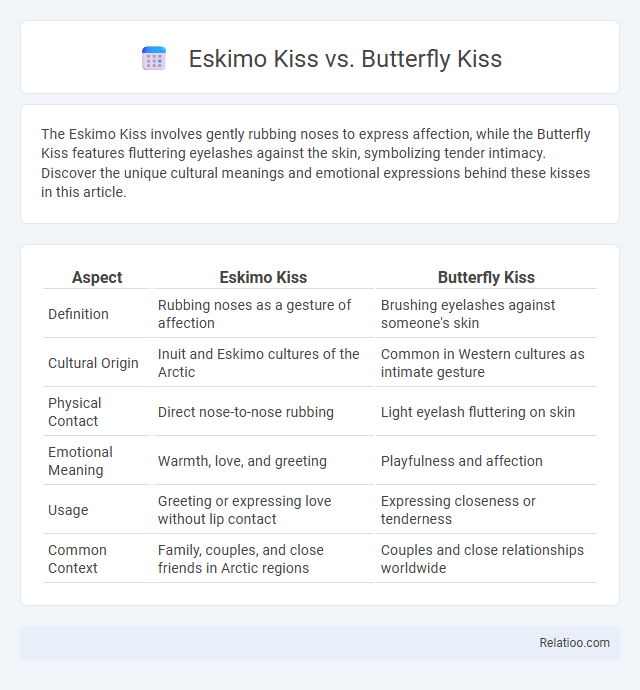The Eskimo Kiss involves gently rubbing noses to express affection, while the Butterfly Kiss features fluttering eyelashes against the skin, symbolizing tender intimacy. Discover the unique cultural meanings and emotional expressions behind these kisses in this article.
Table of Comparison
| Aspect | Eskimo Kiss | Butterfly Kiss |
|---|---|---|
| Definition | Rubbing noses as a gesture of affection | Brushing eyelashes against someone's skin |
| Cultural Origin | Inuit and Eskimo cultures of the Arctic | Common in Western cultures as intimate gesture |
| Physical Contact | Direct nose-to-nose rubbing | Light eyelash fluttering on skin |
| Emotional Meaning | Warmth, love, and greeting | Playfulness and affection |
| Usage | Greeting or expressing love without lip contact | Expressing closeness or tenderness |
| Common Context | Family, couples, and close friends in Arctic regions | Couples and close relationships worldwide |
Introduction to Eskimo Kiss and Butterfly Kiss
Eskimo Kiss involves the gentle rubbing of noses, a traditional gesture of affection rooted in Inuit culture symbolizing warmth and closeness. Butterfly Kiss is characterized by fluttering eyelashes against a loved one's skin, creating a playful and tender sensation without lip contact. Both differ from a standard Kiss, which typically involves pressing lips together to express love or affection.
Origins and Cultural Significance
Eskimo Kiss originates from the Inuit culture, characterized by rubbing noses as a gesture of affection and warmth in harsh Arctic climates. Butterfly Kiss involves fluttering eyelashes against another person's skin, symbolizing intimacy and playfulness, often rooted in contemporary Western expressions of love. The traditional Kiss, widely recognized across cultures, traces back to ancient human rituals symbolizing affection, respect, and bonding, with variations reflecting diverse cultural meanings and social customs worldwide.
What Is an Eskimo Kiss?
An Eskimo kiss involves rubbing noses together gently as a sign of affection, differing from a butterfly kiss, which is created by fluttering eyelashes against another person's skin. Unlike a traditional kiss that uses lips to convey emotion or passion, an Eskimo kiss emphasizes close physical connection without lip contact. This form of greeting or expression often reflects Inuit cultural practices and conveys warmth and intimacy through simple, nose-to-nose contact.
What Is a Butterfly Kiss?
A butterfly kiss involves fluttering one's eyelashes gently against another person's skin, typically their cheek or eyelid, creating a soft, tickling sensation. Unlike an Eskimo kiss, which consists of rubbing noses together, or a traditional kiss that involves lips, a butterfly kiss is purely a delicate, non-lip contact gesture of affection. This type of kiss is often used to express tenderness and playfulness without physical intimacy.
Key Differences Between Eskimo Kiss and Butterfly Kiss
Eskimo Kiss involves rubbing noses together, symbolizing affection and intimacy often seen in Arctic cultures, while Butterfly Kiss is characterized by fluttering eyelashes against someone's skin, creating a gentle and playful sensation. Unlike a traditional Kiss, which involves pressing lips together as a sign of love or greeting, Eskimo Kiss emphasizes tactile connection without lip contact, and Butterfly Kiss focuses on delicate eyelash movement. The primary difference lies in physical interaction: Eskimo Kiss uses the nose for a warm exchange, Butterfly Kiss employs eyelashes for a light, tickling experience, and a standard Kiss involves lips for romantic or social expression.
Common Misconceptions and Myths
Eskimo kisses, butterfly kisses, and traditional kisses are often confused, but each involves distinct physical actions and cultural meanings; an Eskimo kiss is characterized by rubbing noses, a butterfly kiss involves fluttering eyelashes against the skin, and a traditional kiss typically involves pressing lips together. Common misconceptions include the belief that Eskimo kisses are exclusive to Inuit culture or that butterfly kisses are a romantic gesture, when they are often expressions of affection or playfulness instead of passionate intimacy. Your understanding improves by recognizing these differences and the contexts where each type of kiss is appropriate, dispelling myths about their significance or origin.
Emotional and Psychological Impact
Eskimo kisses, characterized by gentle nose rubbing, foster intimacy through subtle physical connection, enhancing feelings of trust and warmth. Butterfly kisses, involving delicate eyelash fluttering against the skin, stimulate emotional closeness by creating a playful and tender bonding experience. Your choice between these gentle gestures and a traditional kiss influences emotional expression, with each type offering unique psychological benefits that deepen affection and reinforce emotional security.
When and How to Share Each Type of Kiss
Eskimo kisses, characterized by the gentle rubbing of noses, are perfect for expressing affection in intimate, quiet moments such as bedtime or early mornings, creating a sweet and tender connection. Butterfly kisses involve fluttering eyelashes against the skin, best shared during playful, lighthearted interactions or when you want to show delicate attention without physical contact. Regular kisses, ranging from pecks to passionate embraces, suit a wide range of occasions from greetings and farewells to romantic encounters, allowing you to convey deeper emotions with varying intensity.
Eskimo Kiss and Butterfly Kiss in Popular Culture
Eskimo kisses, characterized by nose-to-nose rubbing, symbolize affection and intimacy rooted in Inuit culture, frequently depicted in films and literature to evoke warmth and innocence. Butterfly kisses involve fluttering eyelashes against someone's skin, often representing playful tenderness in romantic and familial contexts across social media and advertising. Both Eskimo and Butterfly kisses contrast conventional lip kisses by emphasizing unique, culturally rich expressions of love and connection in popular culture.
Which Kiss Should You Choose?
Choosing between an Eskimo Kiss, a Butterfly Kiss, or a traditional Kiss depends on the level of intimacy and affection you want to convey. An Eskimo Kiss, involving nose rubbing, is playful and sweet, perfect for close friends or family, while a Butterfly Kiss, where eyelashes flutter against the skin, offers a gentle, tender sensation ideal for romantic partners. A traditional Kiss, whether on the lips or cheek, expresses deeper emotional connection and passion, making it the best choice for romantic or significant moments.

Infographic: Eskimo Kiss vs Butterfly Kiss
 relatioo.com
relatioo.com